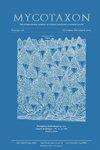墨西哥中部Manilkara zapota上的Chaetocapnodium zapotae sp.nov
IF 0.4
4区 生物学
Q4 MYCOLOGY
引用次数: 1
摘要
从墨西哥韦拉克鲁斯中部的Manilkara zapota中分离到一种新的烟霉Chaetocapnodium zapotae。ITS+LSU核rDNA序列分析表明,该分离物在属水平上与Chaetocapnodium insulare和Chaetocapnodium placitae属于同一支系。形态学检查证实新种与岛草的不同之处在于无性别形态和叶柄上无刚毛。与placitae相比,zapotae的其他特征是其柱头尺寸范围较窄,菌丝和分生孢子的尺寸范围较宽,柱头颜色为深褐色。本文章由计算机程序翻译,如有差异,请以英文原文为准。
Chaetocapnodium zapotae sp. nov. on Manilkara zapota in central Mexico
A new sooty mould, Chaetocapnodium zapotae, was isolated from Manilkara zapota in central Veracruz, Mexico. An analysis of ITS+LSU nuclear rDNA concatenated sequences of our isolate revealed taxonomic identity at the genus level located in the same clade as Chaetocapnodium
insulare and Chaetocapnodium placitae. Morphological examination confirmed that the new species differs from C. insulare in the absence of the sexual morph and the absence of setae on the pycnidia. Additional characters distinguishing C. zapotae from C. placitae
are its narrower pycnidial size range, wider size ranges for the hyphae and conidia, and the dark brown color of its pycnidia.
求助全文
通过发布文献求助,成功后即可免费获取论文全文。
去求助
来源期刊

Mycotaxon
生物-真菌学
CiteScore
1.20
自引率
10.00%
发文量
53
审稿时长
3 months
期刊介绍:
Mycotaxon is a quarterly peer-reviewed journal exclusively devoted to all phases of the taxonomy and nomenclature of fungi (including lichens). All articles are peer-reviewed by specialists prior to acceptance. Publication is open to all persons. Authors prepare their own article after having received critical comments from pre-submission reviewers .The journal is published with one volume each quarter. Articles are accepted in English only, with summaries or abstract in any language(s).
 求助内容:
求助内容: 应助结果提醒方式:
应助结果提醒方式:


